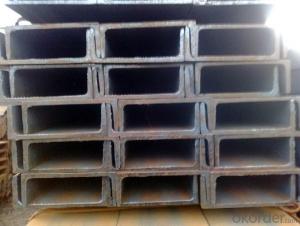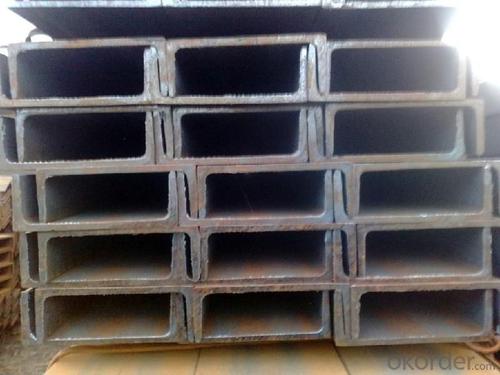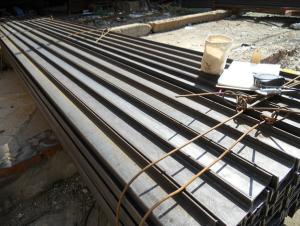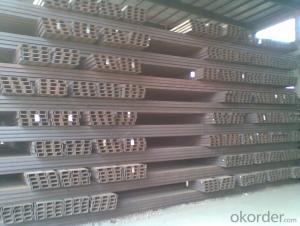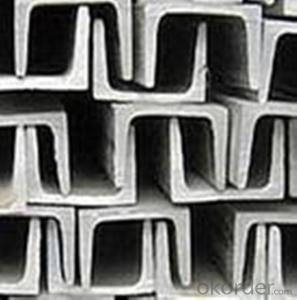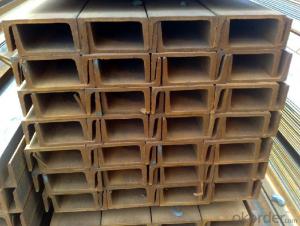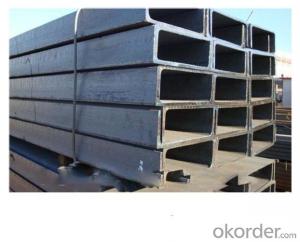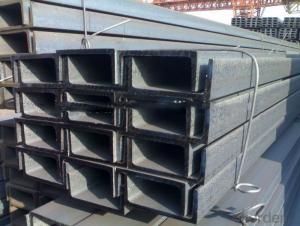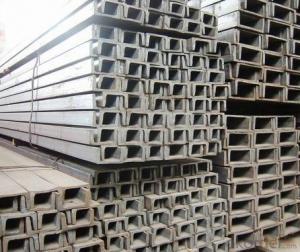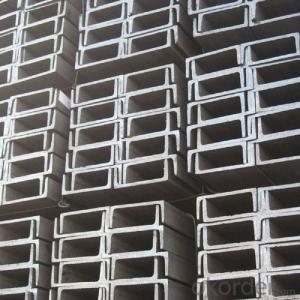Custom Steel Channel (55mm X 6mm)
- Loading Port:
- Qingdao
- Payment Terms:
- TT or LC
- Min Order Qty:
- 10 m.t.
- Supply Capability:
- 5000 m.t./month
OKorder Service Pledge
OKorder Financial Service
You Might Also Like
Custom Steel Channel (55mm X 6mm)
OKorder is offering high quality Custom Steel Channels at great prices with worldwide shipping. Our supplier is a world-class manufacturer of steel, with our products utilized the world over. OKorder annually supplies products to European, North American and Asian markets. We provide quotations within 24 hours of receiving an inquiry and guarantee competitive prices.
Product Applications:
Custom Steel Channels are ideal for structural applications and general fabricating.
Product Advantages:
OKorder's Steel Channels are durable, strong, and resists corrosion.
Main Product Features:
· Premium quality
· Prompt delivery & seaworthy packing (7-10 days after receiving deposit)
· Corrosion resistance
· Can be recycled and reused
· Mill test certification
· Professional Service
· Competitive pricing
Product Specifications:
Base Model
Grade: Q195 / Q235 / Q215 / Q345 / SS400 / S235JR, A36, SS400, SS540, ASTM A36
Height: 55 – 400mm
Thickness: 6 – 14.5mm
Length: As per customer request
Max Dimensions: 55*37*6mm – 400*104*14.5mm
Surface: Painted, galvanized, as per customer request
Punch: Punched as per customer request
Light Model
Grade: Q195 / Q235 / Q215 / Q345 / SS400 / S235JR, A36, SS400, SS540, ASTM A36
Height: 50 – 400mm
Thickness: 6 – 8.0mm
Length: As per customer request
Max Dimensions: 50*32*6mm – 400*115*8.0mm
Surface: Painted, galvanized, as per customer request
Punch: Punched as per customer request
FAQ:
Q1: Why buy Materials & Equipment from OKorder.com?
A1: All products offered byOKorder.com are carefully selected from China's most reliable manufacturing enterprises. Through its ISO certifications, OKorder.com adheres to the highest standards and a commitment to supply chain safety and customer satisfaction.
Q2: How do we guarantee the quality of our products?
A2: We have established an advanced quality management system which conducts strict quality tests at every step, from raw materials to the final product. At the same time, we provide extensive follow-up service assurances as required.
Q3: How soon can we receive the product after purchase?
A3: Within three days of placing an order, we will begin production. The specific shipping date is dependent upon international and government factors, but is typically 7 to 10 workdays.
Q4: What makes stainless steel stainless?
A4: Stainless steel must contain at least 10.5 % chromium. It is this element that reacts with the oxygen in the air to form a complex chrome-oxide surface layer that is invisible but strong enough to prevent further oxygen from "staining" (rusting) the surface. Higher levels of chromium and the addition of other alloying elements such as nickel and molybdenum enhance this surface layer and improve the corrosion resistance of the stainless material.
Q5: Can stainless steel rust?
A5: Stainless does not "rust" as you think of regular steel rusting with a red oxide on the surface that flakes off. If you see red rust it is probably due to some iron particles that have contaminated the surface of the stainless steel and it is these iron particles that are rusting. Look at the source of the rusting and see if you can remove it from the surface.
Images:

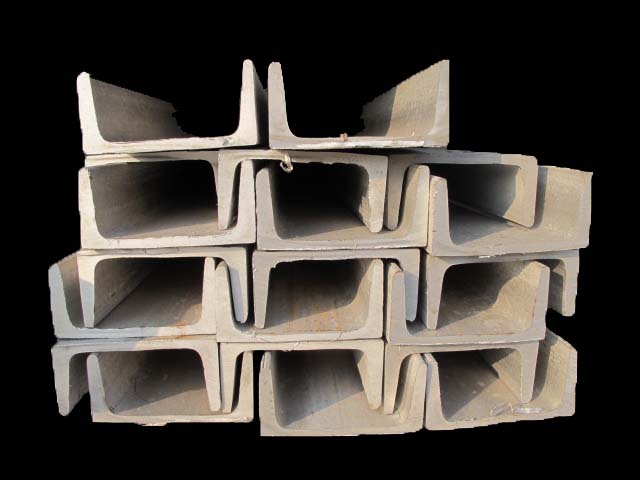


- Q: What are the different methods for designing steel channels for high wind loads?
- There are several methods for designing steel channels for high wind loads. One common approach is to use the Load and Resistance Factor Design (LRFD) method, which takes into account the applied loads, such as wind pressure, and the resistance of the steel channel. Another method is the Allowable Stress Design (ASD) method, which uses a factor of safety to determine the maximum permissible stress in the steel channel. Additionally, computer-aided design (CAD) software can be utilized to analyze and optimize the structural performance of steel channels under high wind loads.
- Q: What are the different shapes of steel channels?
- There are a variety of shapes and sizes of steel channels available to meet different structural and construction needs. Some commonly seen steel channel shapes include: 1. C Channel: Also referred to as a C-shaped channel, it features a straight back and two perpendicular legs. This shape offers excellent structural support and is frequently utilized in building frames, supports, and industrial applications. 2. U Channel: Similar to the C channel, the U channel has a straight back and two parallel legs. It is commonly used as a support for building structures, trailers, and vehicles. 3. Hat Channel: This type of steel channel has a wide, flat top that resembles a hat, with two legs extending downward at an angle. Hat channels are often used for roofing and wall framing in residential and commercial construction. 4. Z Channel: The Z channel is shaped like the letter "Z," with one flange extending upward and the other flange extending downward. It is commonly employed for purlins, studs, and construction applications that require enhanced strength and stability. 5. Box Channel: Box channels have a rectangular shape with four sides of equal length. They are frequently used in construction projects that necessitate structural support, such as for beams, frames, and trusses. These examples represent just a few of the various shapes of steel channels that are available. The selection of a particular shape depends on the specific application and structural requirements of the project.
- Q: How do steel channels contribute to the ease of construction?
- Steel channels contribute to the ease of construction in several ways. Firstly, they provide structural support and stability to various building components. These channels are designed to withstand heavy loads and provide a strong framework for the overall structure. This makes them ideal for use in constructing beams, columns, and joists. Additionally, steel channels are versatile and can be easily customized to meet specific construction requirements. They come in various sizes and shapes, allowing for flexibility in design. This adaptability makes them suitable for a wide range of construction projects, whether it be for industrial buildings, bridges, or residential structures. Moreover, steel channels are lightweight compared to other construction materials, such as concrete. This makes them easier to handle and transport on construction sites, reducing the need for heavy machinery and manpower. The lightweight nature also simplifies the overall construction process and minimizes the time and effort required for installation. Furthermore, steel channels are durable and resistant to various environmental factors, such as corrosion, fire, and termites. This longevity ensures that the structure remains stable and secure over time, reducing the need for frequent repairs or replacements. It also contributes to the overall sustainability of the construction industry by reducing waste and promoting long-term use. In summary, steel channels contribute to the ease of construction by providing structural support, versatility in design, ease of handling, and durability. These qualities make them an essential component in modern construction, improving the overall efficiency and reliability of the construction process.
- Q: Can steel channels be used in the renewable energy parts manufacturing industry?
- Yes, steel channels can be used in the renewable energy parts manufacturing industry. Steel channels are versatile and can be utilized in various applications, including the production of renewable energy equipment such as solar panels, wind turbines, and hydropower systems. The strength, durability, and cost-effectiveness of steel make it a suitable choice for constructing and supporting renewable energy infrastructure.
- Q: What are the different types of steel channel connections for column framing?
- There are several types of steel channel connections used for column framing, including welded connections, bolted connections, and pinned connections. Welded connections involve welding the steel channels together to create a strong and rigid joint. Bolted connections use bolts and nuts to secure the channels together, allowing for easier assembly and disassembly. Pinned connections utilize pins or dowels to connect the channels, providing flexibility and allowing for relative movement between the connected members.
- Q: Standard size and price of 12# channel steel...
- According to the 05 building system quota, the specification 120*53*5.5 (unit mm), the unit price is 4739.90 yuan per ton.
- Q: Channel 20A? What's the matter?
- Channel steel, 20#A specification, 200*73*7.0 theory, weight 22.637
- Q: What are the different load distribution techniques for steel channels in roof systems?
- Steel channels in roof systems can benefit from various load distribution techniques. These techniques play a crucial role in evenly distributing weight and forces on the channels, thus minimizing the chances of structural failure. One effective technique involves utilizing purlins, which are horizontal beams placed on top of the steel channels. These purlins offer additional support and aid in achieving a more uniform load distribution. Depending on the specific requirements of the roof system, purlins can be made from steel, wood, or other suitable materials. Another method is bridging, which entails installing vertical or diagonal braces between the steel channels. This prevents twisting or buckling under heavy loads and spreads the load over multiple channels. By doing so, the overall strength and stability of the channels are significantly enhanced. Furthermore, the spacing between the steel channels themselves plays a crucial role in load distribution. Increasing the spacing between the channels can contribute to a more even distribution of weight, reducing the concentration of load on individual channels. However, it is essential to adhere to recommended spacing guidelines to maintain the structural integrity of the system. Moreover, load-bearing walls or columns can also contribute to load distribution in roof systems. These elements provide additional support at specific points along the channels, effectively distributing the load and preventing excessive stress on individual channels. To summarize, load distribution techniques for steel channels in roof systems encompass the use of purlins, bridging, proper channel spacing, and the incorporation of load-bearing elements. These techniques work in unison to ensure an even distribution of weight and forces on the channels, minimizing the risk of structural failure and ensuring the long-term durability of the roof system.
- Q: Are steel channels suitable for use in the construction of conveyor systems?
- Yes, steel channels are suitable for use in the construction of conveyor systems. They are durable, strong, and provide excellent support for conveying materials. Steel channels can handle heavy loads, offer stability, and are resistant to wear and tear, making them an ideal choice for conveyor systems in various industrial applications.
Send your message to us
Custom Steel Channel (55mm X 6mm)
- Loading Port:
- Qingdao
- Payment Terms:
- TT or LC
- Min Order Qty:
- 10 m.t.
- Supply Capability:
- 5000 m.t./month
OKorder Service Pledge
OKorder Financial Service
Similar products
Hot products
Hot Searches
Related keywords
